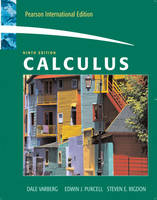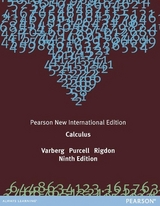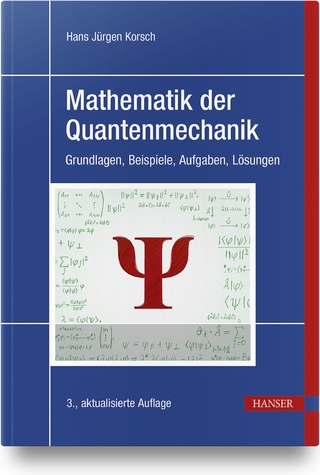
Calculus
Pearson (Verlag)
978-0-13-129331-1 (ISBN)
- Titel erscheint in neuer Auflage
- Artikel merken
For freshman/sophomore-level courses treating calculus of both one and several variables.
Clear and Concise!
Varberg focuses on the most critical concepts freeing you to teach the way you want!
This popular calculus text remains the shortest mainstream calculus book available yet covers all the material needed by, and at an appropriate level for, students in engineering, science, and mathematics. It's conciseness and clarity helps students focus on, and understand, critical concepts in calculus without them getting bogged down and lost in excessive and unnecessary detail. It is accurate, without being excessively rigorous, up-to-date without being faddish. The authors make effective use of computing technology, graphics, and applications. Ideal for instructors who want a no-nonsense, concisely written treatment.
0 PRELIMINARIES
0.1
Real Numbers, Logic and Estimation
0.2
Inequalities and Absolute Values
0.3
The Rectangular Coordinate System
0.4
Graphs of Equations
0.5
Functions and Their Graphs
0.6
Operations on Functions
0.7
The Trigonometric Functions
1 LIMITS
1.1
Introduction to Limits
1.2
Rigorous Study of Limits
1.3
Limit Theorems
1.4
Limits Involving Trigonometric Functions
1.5
Limits at Infinity, Infinite Limits
1.6
Continuity of Functions
1.7
Chapter Review
2 THE DERIVATIVE
2.1
Two Problems with One Theme
2.2
The Derivative
2.3
Rules for Finding Derivatives
2.4
Derivatives of Trigonometric Functions
2.5
The Chain Rule
2.6
Higher-Order Derivatives
2.7
Implicit Differentiation
2.8
Related Rates
2.9
Differentials and Approximations
2.10
Chapter Review
3 APPLICATIONS OF THE DERIVATIVE
3.1
Maxima and Minima
3.2
Monotonicity and Concavity
3.3
Local Extrema and Extrema on Open Intervals
3.4
Graphing Functions Using Calculus
3.6
The Mean Value Theorem for Derivatives
3.7
Solving Equations Numerically
3.8
Antiderivatives
3.9
Introduction to Differential Equations
4 THE DEFINITE INTEGRAL
4.1
Introduction to Area
4.2
The Definite Integral
4.3
The 1st Fundamental Theorem of Calculus
4.4
The 2nd Fundamental Theorem of Calculus
and the Method of Substitution
4.5
The Mean Value Theorem for Integrals & the Use of Symmetry
4.6
Numerical Integration
4.7
Chapter Review
5 APPLICATIONS OF THE INTEGRAL
5.1
The Area of a Plane Region
5.2
Volumes of Solids: Slabs, Disks, Washers
5.3
Volumes of Solids of Revolution: Shells
5.4
Length of a Plane Curve
5.5
Work and Fluid Pressure
5.6
Moments, Center of Mass
5.7
Probability and Random Variables
5.8
Chapter Review
6 TRANSCENDENTAL FUNCTIONS
6.1
The Natural Logarithm Function
6.2
Inverse Functions and Their Derivatives
6.3
The Natural Exponential Function
6.4
General Exponential & Logarithmic Functions
6.5
Exponential Growth and Decay
6.6
First-Order Linear Differential Equations
6.7
Approximations for Differential Equations
6.8
Inverse Trig Functions & Their Derivatives
6.9
The Hyperbolic Functions & Their Inverses
6.10
Chapter Review
7 TECHNIQUES OF INTEGRATION
7.1
Basic Integration Rules
7.2
Integration by Parts
7.3
Some Trigonometric Integrals
7.4
Rationalizing Substitutions
7.5
The Method of Partial Fractions
7.6
Strategies for Integration
7.7
Chapter Review
8 INDETERMINATE FORMS & IMPROPER INTEGRALS
8.1
Indeterminate Forms of Type 0/0
8.2
Other Indeterminate Forms
8.3
Improper Integrals: Infinite Limits of Integration
8.4
Improper Integrals: Infinite Integrands
8.5
Chapter Review
9 INFINITE SERIES
9.1
Infinite Sequences
9.2
Infinite Series
9.3
Positive Series: The Integral Test
9.4
Positive Series: Other Tests
9.5
Alternating Series, Absolute Convergence,
and Conditional Convergence
9.6
Power Series
9.7
Operations on Power Series
9.8
Taylor and Maclaurin Series
9.9
The Taylor Approximation to a Function
9.10
Chapter Review
10 CONICS AND POLAR COORDINATES
10.1
The Parabola
10.2
Ellipses and Hyperbolas
10.3
Translation and Rotation of Axes
10.4
Parametric Representation of Curves
10.5
The Polar Coordinate System
10.6
Graphs of Polar Equations
10.7
Calculus in Polar Coordinates
10.8
Chapter Review
11 GEOMETRY IN SPACE, VECTORS
11.1
Cartesian Coordinates in Three-Space
11.2
Vectors
11.3
The Dot Product
11.4
The Cross Product
11.5
Vector Valued Functions & Curvilinear Motion
11.6
Lines in Three-Space
11.7
Curvature and Components of Acceleration
11.8
Surfaces in Three Space
11.9
Cylindrical and Spherical Coordinates
11.10
Chapter Review
12 DERIVATIVES OF FUNCTIONS OF TWO OR MORE VARIABLES
12.1
Functions of Two or More Variables
12.2
Partial Derivatives
12.3
Limits and Continuity
12.4
Differentiability
12.5
Directional Derivatives and Gradients
12.6
The Chain Rule
12.7
Tangent Planes, Approximations
12.8
Maxima and Minima
12.9
Lagrange Multipliers
12.10
Chapter Review
13 MULTIPLE INTEGRATION
13.1
Double Integrals over Rectangles
13.2
Iterated Integrals
13.3
Double Integrals over Nonrectangular Regions
13.4
Double Integrals in Polar Coordinates
13.5
Applications of Double Integrals
13.6
Surface Area
13.7
Triple Integrals (Cartesian Coordinates)
13.8
Triple Integrals (Cyl & Sph Coordinates)
13.9
Change of Variables in Multiple Integrals
13.1
Chapter Review
14 VECTOR CALCULUS
14.1
Vector Fields
14.2
Line Integrals
14.3
Independence of Path
14.4
Green's Theorem in the Plane
14.5
Surface Integrals
14.6
Gauss's Divergence Theorem
14.7
Stokes's Theorem
14.8
Chapter Review
APPENDIX
A.1
Mathematical Induction
A.2
Proofs of Several Theorems
A.3
A Backward Look
| Erscheint lt. Verlag | 6.4.2006 |
|---|---|
| Sprache | englisch |
| Maße | 277 x 217 mm |
| Gewicht | 1740 g |
| Themenwelt | Mathematik / Informatik ► Mathematik ► Analysis |
| ISBN-10 | 0-13-129331-1 / 0131293311 |
| ISBN-13 | 978-0-13-129331-1 / 9780131293311 |
| Zustand | Neuware |
| Haben Sie eine Frage zum Produkt? |
aus dem Bereich



